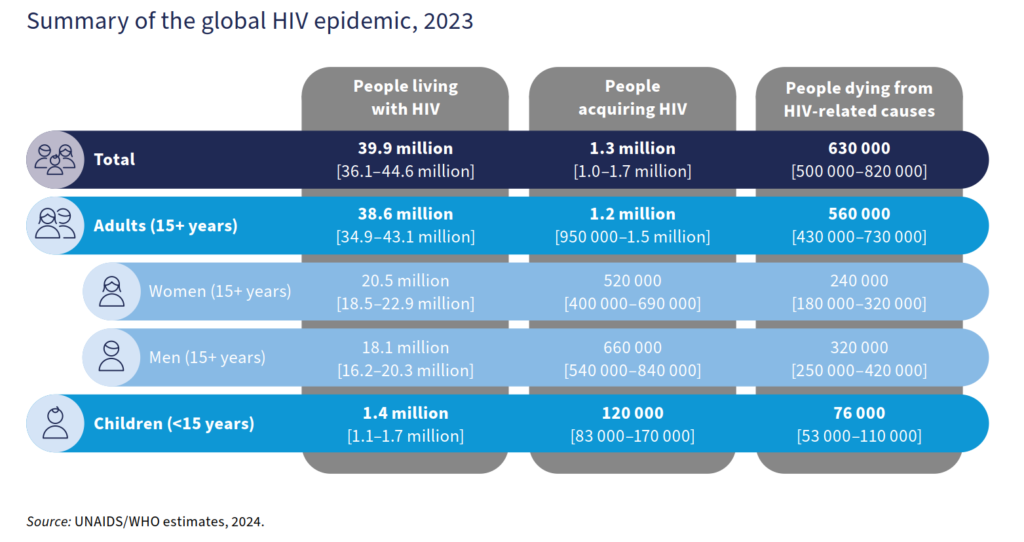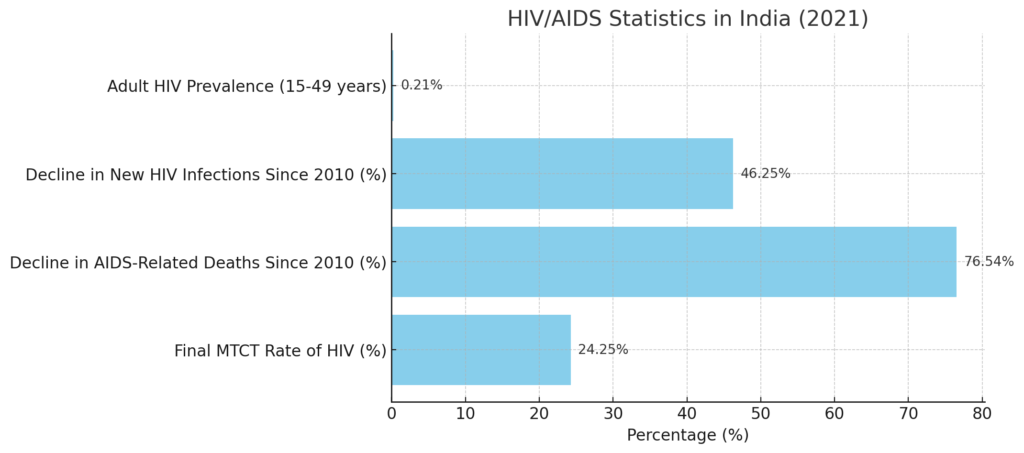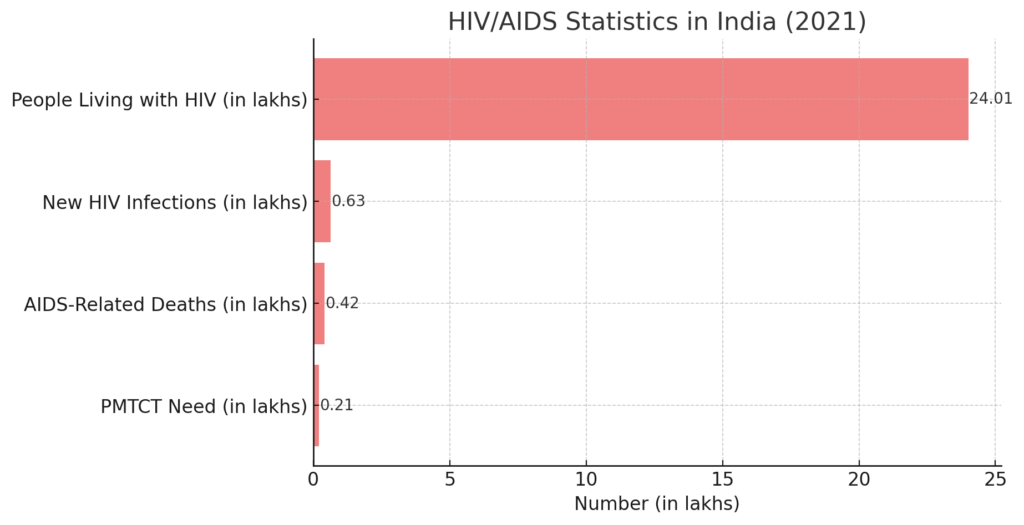Introduction
In June 1981, the first known case of Human Immunodeficiency Virus (HIV) was diagnosed in Los Angeles, USA. Since then, we’ve made huge strides in fighting HIV/AIDS. We’ve improved prevention, diagnosis, care, and treatment. Newer drugs are now more effective and less harmful. The cost of therapy has dropped, and access to treatment has expanded. What was once seen as a death sentence in the 1980s is now a manageable chronic disease. This article will discuss the global prevalence and prevalence in India.
Global HIV and AIDS Epidemic
Since the start of the HIV epidemic, about 88.4 million people have been infected with the virus. Around 42.3 million people have died from HIV-related illnesses.
According to WHO, by the end of 2023, about 39.9 million people worldwide were living with HIV. Approximately 0.6% of adults aged 15–49 years are living with HIV. The impact of the epidemic varies greatly between different countries and regions.
By the end of 2023, 77% of people with HIV (PLHIV), or about 30.7 million people, were receiving antiretroviral therapy (ART) worldwide (HIV.gov). Access to HIV treatment is crucial in the global fight to end AIDS as a public health threat.

Prevalence of HIV In India, 2021 Estimate [Source: NACO]
At the national level, the adult HIV prevalence in India for ages 15-49 has been declining since it peaked in 2000 at 0.55%. By 2010, it had dropped to 0.32%, and by 2021, it was further reduced to 0.21%. In particular, the northeastern states have the highest adult HIV prevalence, with Mizoram at 2.70%, Nagaland at 1.36%, and Manipur at 1.05%. Meanwhile, in the southern states, Andhra Pradesh has a prevalence of 0.67%, Telangana at 0.47%, and Karnataka at 0.46%. Overall, about 24 lakh people are currently living with HIV in India, with Maharashtra, Andhra Pradesh, and Karnataka having the highest numbers.
In 2021, India saw about 62,970 new infections. Remarkably, this marks a 46.3% decline in new infections nationally from 2010 to 2021. Additionally, states like Himachal Pradesh, Tamil Nadu, and Telangana showed the fastest declines, with decreases of around 73%, 72%, and 71%, respectively. However, some northeastern states, such as Tripura, Meghalaya, and Arunachal Pradesh, are seeing an upward trend.
AIDS-related deaths in India were estimated at 41,970 in 2021, showing a 76.5% decline from 2010 to 2021. This decrease was observed in most states, except for Puducherry, Arunachal Pradesh, Meghalaya, and Tripura. The highest reductions in AIDS-related deaths were seen in Chandigarh, Telangana, and West Bengal.
The need for Prevention of Mother-to-Child Transmission (PMTCT) services was estimated at 20,612 cases in 2021. The highest needs were in Maharashtra (12.9%), Bihar (11.9%), and Uttar Pradesh (10.6%).
The 2021 estimates highlight the need for targeted HIV Prevention, testing, and treatment efforts in different states. Since the epidemic is not evenly spread across the country, more detailed planning is needed to effectively address the disease in various regions.
Summary of HIV Epidemic In India
Adult HIV Prevalence (15-49 years):
As of 2021, about 0.21% of adults aged 15-49 in India are living with HIV. This includes 0.22% of men and 0.19% of women.
People Living with HIV (in lakhs):
There are around 24.01 lakh PLHIV in India. This includes 23.31 lakh adults, 10.50 lakh women, and 0.70 lakh children under 15 years.
HIV Incidence per 1000 Uninfected:
For every 1,000 uninfected people, about 0.05 are getting infected with HIV each year. The rate is 0.05 for men and 0.04 for women.
New HIV Infections (in thousands):
In 2021, there were around 62,970 new infections in India. This includes 57,970 adults, 24,550 women, and 15,080 young people aged 15-24.
Decline in New HIV Infections Since 2010 (%):
Since 2010, there has been a 46.25% decline in new infections in India. This includes a 44.48% decline among adults, 43.75% among women, and 60.82% among children under 15 years.
AIDS-Related Deaths (in thousands):
In 2021, there were about 41,970 deaths due to AIDS-related illnesses in India. This includes 39,460 adults, 11,260 women, and 2,510 children under 15 years.
Decline in AIDS-Related Deaths Since 2010 (%):
AIDS-related deaths have dropped by 76.54% since 2010. The decline is 76.44% for adults, 82.74% for women, and 77.92% for children under 15 years.
PMTCT Need (in thousands):
There is a need for 20,610 services related to the Prevention of Mother-to-Child Transmission (PMTCT) of HIV in India. The highest needs are in Maharashtra, Bihar, and Uttar Pradesh.
Final MTCT Rate of HIV (%):
The final rate of mother-to-child transmission (MTCT) of HIV is estimated to be around 24.25%, ranging from 18.50% to 29.50%.


Conclusion
In conclusion, significant progress has been made in the global and Indian fight against HIV/AIDS over the past few decades. Globally, millions of lives have been saved and improved due to advances in treatment, particularly antiretroviral therapy (ART). The expansion of ART has transformed HIV from a fatal disease into a manageable chronic condition, contributing greatly to the decline in new infections and AIDS-related deaths.
In India, the decline in HIV prevalence and new infections since 2000 reflects the success of targeted interventions and treatment programs. However, disparities still exist across regions and demographics. Some states in India continue to see rising infection rates, highlighting the need for ongoing, region-specific efforts. Additionally, the need for services like Prevention of Mother-to-Child Transmission (PMTCT) remains critical to controlling the epidemic.
While the overall picture shows encouraging trends, it is clear that the fight against HIV/AIDS is far from over. Continuous efforts are needed to ensure access to prevention, testing, and treatment for all, particularly in areas and among populations still heavily affected by the epidemic. With sustained commitment and strategic planning, further reductions in new infections and deaths can be achieved, moving closer to the goal of ending AIDS as a public health.
